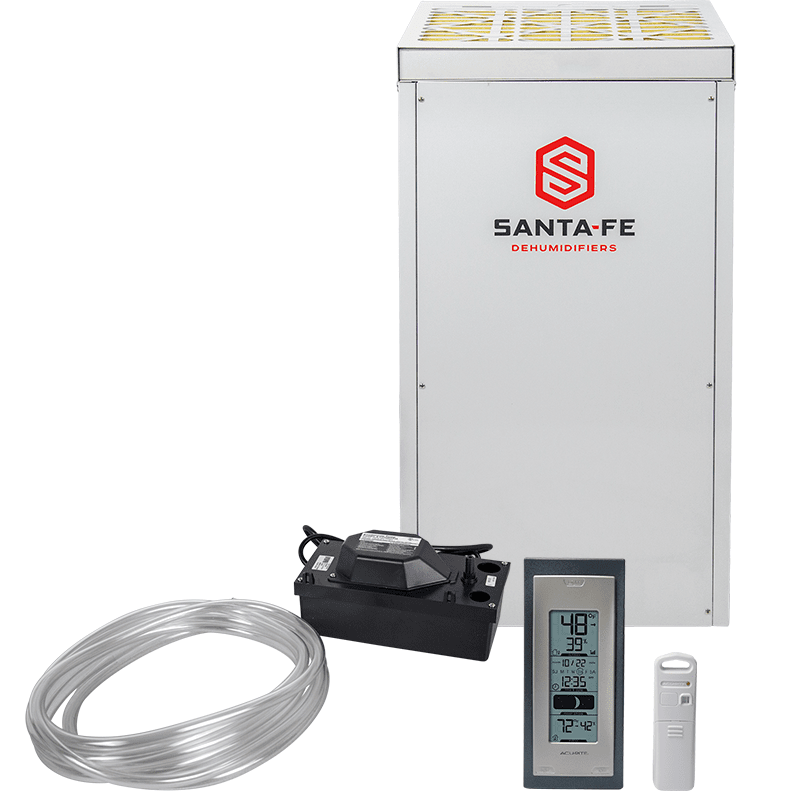Dehumidifier

Eliminate Damp & High Humidity in the Home
By Rik Ravado
When the weather is cold, windows are kept closed and humidity builds up in the home, resulting in dampness. Excess moisture in the air may also be a problem, depending on climate, due to high humidity outdoors. This article describes how to remove excessive moisture generated inside the house.
Modern homes are increasingly well insulated and sealed, making excessive build-up of moisture inside the home a bigger problem than in the past. A common sign of high humidity is that the insides of windows, even if double glazed, steam up.
Mold on ceilings, window frames, outside walls and in closets (wardrobes) is another indication of dampness. Within a closet you may find mold growing on clothing, shoes and other items such as plastics.
Where does the moisture come from? If it is humid outdoors this may be the cause but usually it is generated within your own home. Typical moisture sources in the home include toilets, baths and showers, washing machines, sinks, fish tanks, drying clothes, people and pets. Therefore, if you don't have an extractor fan, open the bathroom window after a bath or shower.
Humans continually generate moisture from sweat and breathing. You'll notice the humidity in your bedroom is higher in the morning. Why? Because you have been sleeping in the room for several hours.
Yes even the guinea pig and the cat are contributing to your household humidity! If you have air conditioning this can solve the problem but, if not, other solutions may be needed.
The first thing to do is measure the humidity in each room. You can buy an electronic humidity meter for a few dollars (pounds) from Ebay or Amazon. A reading of up to 50% is fine and will not support mold growth.
Once the humidity gets up to around 70%, however, you are likely to get mold and dust mites will also flourish. Dust mites can cause allergies and chest problems. High humidity also encourages clothes moths, fleas, cockroaches and woodlice.
How can you reduce humidity? First you can open windows during the day and get some fresh air in the house and allow excess moisture to disappear. You can check using your humidity meter if this solves the problem.
Obviously, if the climate where you are is very cold then opening the windows may not be a practical solution. You can also cover open sources of water such as fish tanks or toilets (close the lid) and keep bathroom doors closed after you have had a bath or shower.
If opening the windows isn't enough then you may need a dehumidifier. Domestic dehumidifiers are relatively inexpensive and are available on sites like Amazon and Ebay starting at around $150 (£100) for a model suitable for an apartment or flat with models suitable for a 4-bedroom house available for around $250 (£160).
Domestic dehumidifiers normally use one of two technologies: refrigeration or desiccant (the use of a material that absorbs moisture). Refrigeration results in water condensing from the air and being collected.
The dry air is then reheated to the ambient temperature and recirculated. The Desiccant models allow water to be absorbed by a special material from the damp air. The material is then dried and the resulting water collected and stored.
Desiccant models use more power but do heat the air in the room as well as drying it. They are also more effective for low temperatures so are ideal for drying unheated rooms or spaces such as a caravan or outhouse.
Here are some features of dehumidifiers that you need to consider:
Water Capacity
The minimum tank capacity is around 2 litres or 0.5 of a US gallon. Most models also have an alarm to warn you when the tank is nearly full. If you want to leave your dehumidifier unattended, most models allow you to attach a drain tube and bypass the tank. However, to use the tube you need a nearby sink or drain to take the water.
Energy Consumption
Consider how often you want to run the machine and get an idea how much it will cost to run per week. Generally the bigger the floor area the machine can keep dry the higher the running costs.
Dimensions and Weight
If you want to move your dehumidifier around then make sure you can easily carry it. A smaller machine would typically weigh around 6 kg (13 lb). Look for a solid carrying handle and remember to empty the tank before you move it. You'll also need an electrical socket fairly close by (or an extension lead).
Extraction Rate
These machines typically extract 4-10 litres of water a day. Choose the rate based on how many rooms you want to keep dry.
Laundry Mode
Dehumidifiers are great for drying clothes. Some machines have a Laundry Mode that keeps extracting water regardless of the humidity level in the room so clothes dry quicker.
Other features
Check the output noise of the machine if you want to run it in a quiet location. For example if you want to operate it in a bedroom when someone is asleep. If you want to run your machine via a time switch make sure it will automatically extract moisture as soon as the power is switched on.
Conclusion
Finally, if your home is showing signs of damp or mold then first buy a humidity meter and see if your home is too humid. If opening windows or using extractor fans doesn't solve the problem then consider the purchase of a domestic dehumidifier. These are easy to operate and generally work straight out of the box.
Testing
Santa Fe Classic Dehumidifier
This Santa Fe dehumidifier is our top-rated unit for large basements that are plagued by excess humidity. Efficient and economical, this basement dehumidifier can remove 100 pints...
More Info >>
 Disclaimer: Articles not intended to Diagnose, Treat, Cure or Prevent Diseases.
Disclaimer: Articles not intended to Diagnose, Treat, Cure or Prevent Diseases.
Issues | Conditions | Products | Testing



